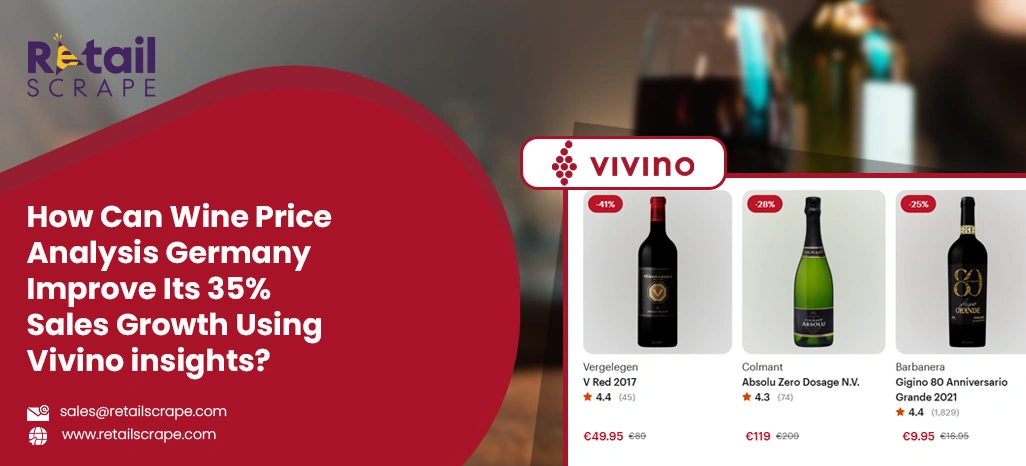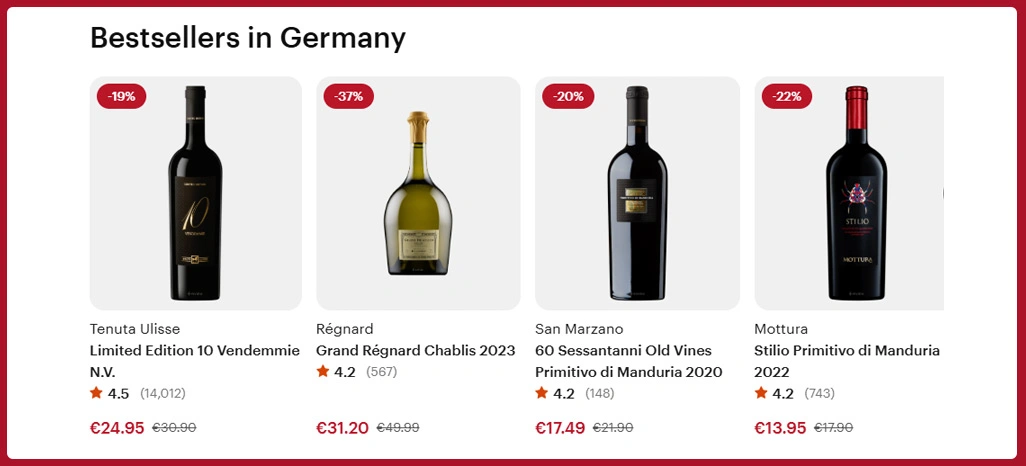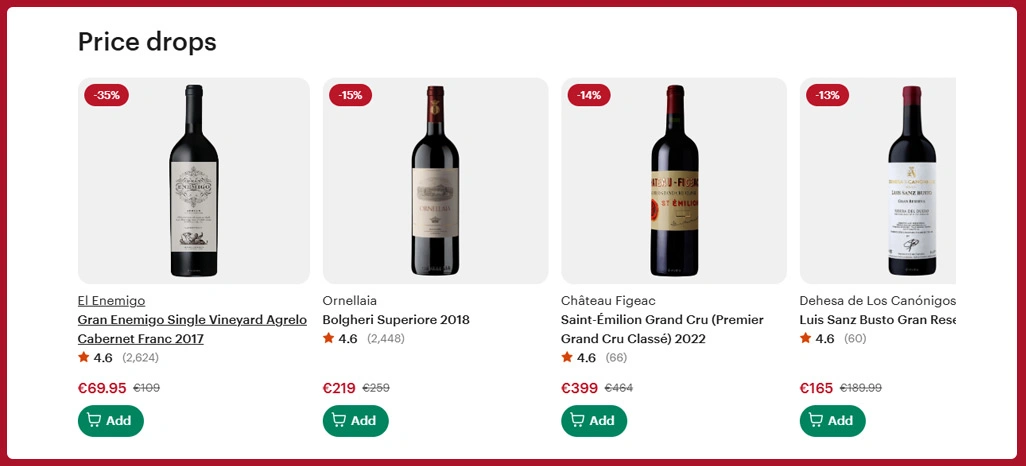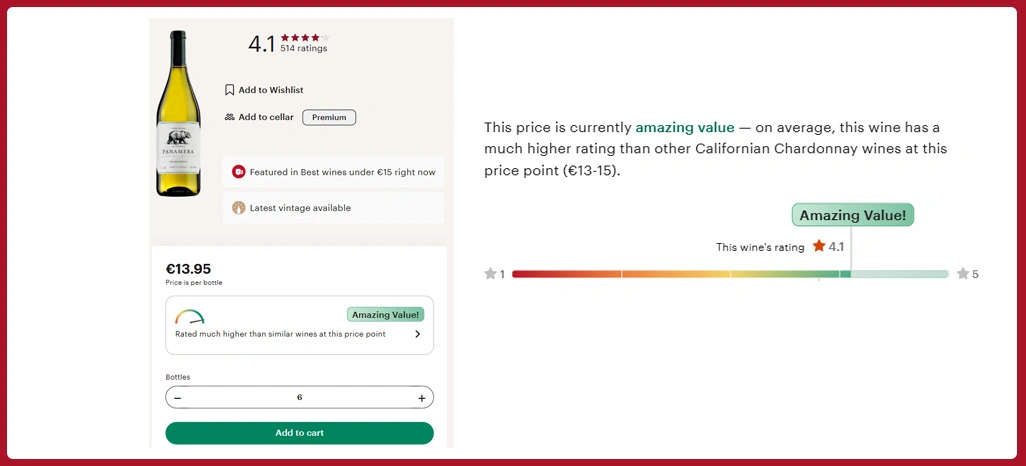How Can Wine Price Analysis Germany Improve Its 35% Sales Growth Using Vivino insights?

Introduction
The German wine industry has seen remarkable growth in the past few years, with a 35% increase in sales driven by evolving consumer preferences and the rise of digital commerce. To sustain this pace and improve profitability, wineries and retailers are increasingly relying on Wine Price Analysis Germany for strategic decision-making. By combining detailed market research with digital insights, wine producers can better understand trends, optimize pricing, and align with market demand.
With the help of Vivino Data Scraping , retailers can gather extensive data on product ratings, reviews, and real-time price shifts across competitors. This enables actionable insights that were once difficult to capture manually. As Germany’s wine e-commerce market becomes more data-driven, those who integrate pricing intelligence and competitor evaluation gain a distinct edge in profitability and positioning.
By analyzing price fluctuations, customer feedback, and demand elasticity, businesses can make data-driven choices supported by actionable insights. This approach helps retailers enhance Wine Sales Optimization Germany, refine pricing strategies, improve marketing effectiveness, and elevate customer satisfaction—driving steady sales growth and reinforcing brand credibility.
Building Deeper Insights into Wine Retail Dynamics

Understanding the complexity of Germany’s growing wine industry requires precision-driven analytics that bridge the gap between consumer behavior and pricing trends. Retailers need more than simple sales data — they need actionable insights that reflect demand elasticity, regional performance, and competitor movements. This is where Wine Market Analysis becomes a game-changer, offering a detailed understanding of price sensitivities and consumption shifts across regions.
In Germany, over 42% of consumers make purchase decisions after comparing prices across multiple online platforms. This highlights the growing importance of transparency and accurate evaluation in the retail ecosystem. With evolving purchasing patterns and diverse varietal interests, businesses must rely on structured datasets that enable quick recognition of profitable opportunities and underperforming segments.
By integrating structured data into business decisions, brands can visualize when to modify pricing, optimize inventory distribution, and design promotions that resonate with consumers. The use of Wine Pricing Insights Germany helps identify consumer demand clusters, recognize high-performing SKUs, and maintain consistent brand positioning.
| Metric | Key Observation | Strategic Response |
|---|---|---|
| Average price gap | 8–12% across regions | Calibrate pricing per local preference |
| Leading varietals | Riesling, Pinot Noir | Prioritize stock based on demand |
| Digital influence | 62% depend on reviews | Align offers with online sentiment |
| Promotion frequency | Every 10–12 weeks | Time discounts to market trends |
The adoption of analytical strategies gives retailers the ability to balance value and profitability while ensuring competitive alignment. Through E-Commerce Wine Pricing Strategy, companies can refine retail performance and meet consumer expectations effectively, ensuring steady growth in Germany’s dynamic wine landscape.
Elevating Competitive Awareness through Price Intelligence Tools

Maintaining an edge in a highly competitive marketplace demands more than traditional observation—it requires structured intelligence that reveals real-time shifts in rival pricing behavior. German wine retailers increasingly depend on Competitor Price Tracking Germany to understand where they stand in the market and how to position their offerings effectively.
By studying competitor benchmarks, pricing models, and discount timelines, businesses gain insight into emerging strategies that influence consumer decisions. Research shows that brands conducting weekly competitor assessments outperform others by nearly 23% in sales consistency. These analytics reveal when rivals introduce discounts, how premium brands maintain their margin advantages, and which new entrants are influencing price sensitivity among buyers.
When paired with Wine Pricing Insights Germany, retailers can use these findings to recalibrate their pricing tiers, target specific customer groups, and stabilize revenues. This ensures their prices remain relevant without undercutting value perception or diminishing brand quality.
| Competitor Factor | Market Impact | Recommended Action |
|---|---|---|
| Discount cycles | 15% every quarter | Introduce targeted time-bound promotions |
| Premium brand markup | 10% on average | Maintain perceived value positioning |
| New retailer pricing | 6% below industry norm | Retain buyers through reward programs |
| Data refresh rate | Weekly intervals | Implement agile pricing decisions |
With informed strategies derived from Wine Market Analysis, retailers can create pricing structures that not only attract customers but also safeguard profit margins. This balance of insight and agility allows long-term competitiveness in Germany’s evolving digital wine economy.
Advancing Retail Success through Live Price Monitoring

Real-time analytics have become essential in the fast-paced e-commerce environment, where even minor delays can cost substantial revenue. With Real-Time Wine Price Monitoring , retailers can gain continuous visibility into fluctuating price movements, competitive offers, and evolving demand trends.
Businesses adopting this system achieve immediate access to changes in consumer response and regional variations, ensuring they stay proactive instead of reactive. Instant alerts enable sellers to respond to competitor markdowns, special events, or festival-induced demand surges without compromising profitability.
According to recent studies, real-time data monitoring has led to a 28% average increase in sales during promotional periods. Retailers leveraging continuous updates can synchronize marketing campaigns, optimize seasonal discounts, and maintain stable price parity across multiple channels.
The inclusion of Wine Pricing Insights Germany enhances operational control, as it correlates live data with performance outcomes. This ensures retailers maintain consistency in pricing standards while preventing revenue leakage caused by late reactions or outdated pricing structures.
| Monitoring Element | Review Frequency | Retail Outcome |
|---|---|---|
| Price deviation alerts | Hourly updates | Prevent underpricing and loss |
| Competitor changes | 2–3 hours delay | Maintain parity and responsiveness |
| Promo period growth | 28% higher sales | Refine discount strategy |
| Out-of-stock alerts | Instant tracking | Improve restocking efficiency |
Using these analytical tools alongside E-Commerce Wine Pricing Strategy enables retailers to strengthen performance visibility, streamline decisions, and sustain continuous success within Germany’s competitive wine market.
Responding to Buyer Behavior with Adaptive Pricing Models

The ability to modify pricing in response to consumer activity defines modern retail competitiveness. Adaptive systems such as Dynamic Pricing for Wine Retailers empower businesses to align their price points with real-time demand patterns, seasonal variations, and purchasing triggers.
This flexible framework helps maintain equilibrium between profitability and customer appeal. A recent German study found that brands applying adaptive pricing saw up to 19% improvement in overall margins, even during slower sales periods. It ensures that retailers remain aligned with consumer behavior while preventing revenue stagnation.
With the support of Wine Market Analysis, brands can identify where price adjustments will generate the highest returns. Seasonal shifts—like regional wine festivals or rising interest in organic wines—often influence buying patterns. Responsive pricing allows retailers to optimize revenue while building loyalty through fair and transparent adjustments.
| Variable | Observed Change | Strategic Adjustment |
|---|---|---|
| High-season demand | +14% surge | Increase price within acceptable limits |
| Low-season elasticity | –7% fluctuation | Offer bundled promotions |
| Local festival impact | +21% uplift | Target region-specific campaigns |
| Personalized pricing | Better engagement | Enhance conversion rates |
The inclusion of Wine Pricing Insights Germany ensures adaptability without compromising consumer trust. This harmony between responsiveness and strategy builds brand resilience and long-term profitability for modern wine retailers.
Integrating Broader Alcohol Intelligence for Cross-Market Success

To maintain competitive advantage, wine retailers must evaluate their performance within the context of the entire alcohol industry. Implementing Alcohol Market Intelligence provides a 360-degree understanding of price correlations, brand positioning, and consumer substitution patterns across different liquor segments.
This approach enables retailers to anticipate market shifts and align their strategies accordingly. For example, when beer or spirits experience discount cycles, wine sales often see parallel fluctuations in consumer interest. By aligning with these insights through Wine Pricing Insights Germany, businesses can proactively balance inventory and pricing across multiple categories.
Recent analyses show that understanding cross-category dynamics can raise conversion rates by nearly 24%. It helps retailers not only prevent sales drops during off-seasons but also capitalize on inter-category demand surges.
| Segment | Observed Market Shift | Retail Advantage |
|---|---|---|
| Cross-liquor pricing | 11% influence | Predict competitive reactions |
| Alcohol consumption pattern | +17% variation | Align marketing accordingly |
| Online vs offline price gap | 9% discrepancy | Strengthen online presence |
| Import cost fluctuations | Moderate increase | Adjust pricing models |
Adopting broader analytical visibility supported by E-Commerce Wine Pricing Strategy empowers businesses to fine-tune decisions, expand audience reach, and maintain sustainable sales growth across the German beverage sector.
Achieving Accuracy through API-Based Data Integration

Automation has become indispensable in the digital age. Retailers utilizing Liquor Scraping API can seamlessly extract detailed pricing and product information from various online sources, ensuring consistent accuracy and speed in decision-making.
This integration reduces manual effort while expanding scalability, allowing monitoring across thousands of SKUs without delay. Businesses employing this system achieve higher precision in pricing decisions, improved SKU management, and efficient resource allocation. When combined with Wine Market Analysis, API-based workflows eliminate data redundancy and enhance reliability.
A key advantage lies in real-time updates — errors are reduced, and insights become standardized across channels. Retailers can instantly identify pricing gaps, forecast trends, and respond to competitor shifts with confidence.
| Data Category | API Efficiency | Operational Impact |
|---|---|---|
| Price update timing | Instantaneous | Ensure current pricing accuracy |
| Manual error rate | Reduced by 90% | Improve data reliability |
| SKU tracking capacity | 10× improvement | Expand product oversight |
| Data standardization | 100% achieved | Streamline analytics reporting |
Combining automation with Wine Pricing Insights Germany ensures precision, scalability, and consistent control over decision-making processes. This creates a strong analytical foundation that sustains growth and operational excellence in Germany’s competitive online wine retail market.
How Retail Scrape Can Help You?
We empower businesses to transform their growth strategies with actionable data solutions. Through our advanced tools and automation frameworks, clients can efficiently utilize Wine Price Analysis Germany to monitor price shifts, assess competition, and forecast future trends with accuracy and ease.
Our specialized services include:
- Automated competitor and product data extraction.
- Real-time market visibility and insights.
- Efficient SKU and category-level tracking.
- Smart inventory management solutions.
- On-demand report generation.
- End-to-end integration with business analytics systems.
With the ability to process high-volume data at speed, we ensure smarter pricing and better alignment with market needs. Every solution is designed to complement your pricing strategies, ensuring long-term success supported by Intelligent Pricing for Wine Retailers. By pairing innovative analytics with scalable technology, we help clients convert raw data into actionable intelligence for sustained profitability.
Conclusion
Germany’s wine industry is undergoing a digital transformation where Wine Price Analysis Germany plays a vital role in redefining how retailers plan, price, and perform. Using accurate insights derived from structured data, businesses can make smarter choices that foster both profitability and customer satisfaction.
With continuous digital advancement, data-driven models are becoming essential to achieving sustained results. Enhanced efficiency and better decision-making through Wine Pricing Insights Germany ensure businesses maintain a leading edge in today’s competitive marketplace.
Want to transform your wine pricing strategy and outperform competitors? Contact Retail Scrape today to get started with custom wine market intelligence solutions.
